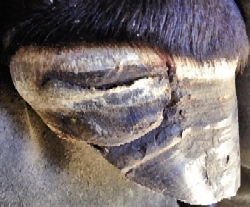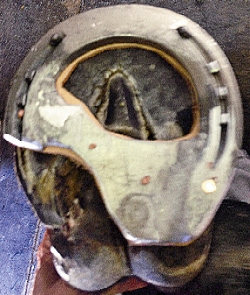When the hoof is injured during a race, it is usually the hind foot striking the front and nearly always involves the rear third of the affected hoof. Of course, there are many other ways a horse might incur a hoof, but this particular injury involves the most critical area of racehorse shoeing.
This is the area where we deal with 90 percent of the hoof soreness and lameness issues in racehorses. Sore heels, bruises, quarter cracks, broken bars and abscesses all occur within that critical back part of the hoof. Once that part of the hoof is injured, one must really be “on their toes” in terms of hoof care from that point forward.
Until the injury has had a chance to grow far enough away from the coronet band (where hoof meets hair), it can be troublesome. Far enough from the coronet band means having sufficient new healthy hoof horn to support the sensitive tissues there. This can take months.
Also of note is the fact that if the coronet band itself is injured badly enough, the new hoof growth below the remaining scare may never be normal again.
After the initial damage, there is often enough healthy hoof wall below the injury to maintain the hoof capsule integrity. However, as the affected foot grows down, the hoof wall structure becomes increasingly impaired. This is because the healthy hoof a farrier must trim away is replaced by the weakened hoof wall as the injured part of the hoof grows down.
When things reach this point, shoeing strategies must adapt. Even if the hoof was perfectly healthy and sound before the injury, now you must shoe as if it is a quarter crack or heel separation because that is what it will become. (Fig. 1)
 (Photos by the author) Fig. 1
(Photos by the author) Fig. 1
The extent of the injury will determine the shoeing needs. I chose a window bar (Fig. 2) for this horse because of the large area of separated hoof wall. The separated hoof wall is removed to prevent it from irritating the sensitive tissue beneath. When the continuity is lost between those layers of the hoof capsule, the hard hoof wall will now rub against the soft sensitive tissues it was supporting. This can cause bleeding, lameness, or even infection.
Once that part of the hoof wall is removed (Fig. 3), one can move on with treatment and shoeing. The exposed sensitive tissue will harden after being exposed to air. This can be accelerated by using a drying agent. I have found that lime works well. Just take the lime that is used by many stables to sprinkle on the bed of a wet stall to counteract the urine there. Use 3-4 tablespoons (enough to fill the palm of your hand). No need to be exact. Put in on the exposed hoof tissue and tape it there with vet wrap. Change this every day and after 3-4 days, that tissue will be much more firm and less sensitive.
 Fig. 2
Fig. 2
At this stage, it is time for the farrier to decide whether to repair it with a patch. As was the case in Figure 3, I decided the area was too large and without enough good wall to anchor to in the heels and simply shod the hoof to relieve pressure in that area. This horse went on to race very well in a stakes series wearing that shoe.
After the new growth has yielded at least one inch of healthy hoof between the injury and hairline, I believe you can transition back to normal shoeing, but each situation needs its own scrutiny in that regard.
So even though the initial wound of an injury heals reasonably quickly, the lasting insult of a damaged hoof might be around longer than a guest who has overstayed their welcome, and can be harder to get rid of.
Veteran Standardbred farrier Steve Stanley of Lexington, Ky., authors a monthly column for Hoof Beats, the official harness racing publication of the U.S. Trotting Association. The American Farriers Journal Editorial Advisory Board member offers plenty of practical advice that will be of special interest regardless of the type of horses that you work with. Click here to read more from Steve Stanley's Hoof Beats series.








Post a comment
Report Abusive Comment